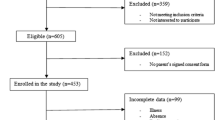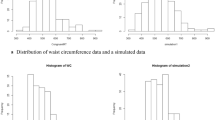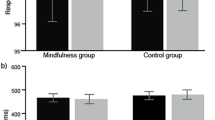Abstract
Background and purpose
The association between weight status with simple cognitive tasks such as reaction time (RT) may not be observed in young people as cognitive functioning development has reached its peak. In the present study, we aimed to examine the association between overall and central adiposity with overall and central processing of RT in a sample of young adult men with different weight status from Ardabil, Iran.
Methods
Eighty-six young males between June-July 2018 completed RT tests as well as premotor time (PMT) using surface electromyography changes in isometric contraction response to an audio stimulus.
Results
No significant associations were observed between RT and PMT and different body mass index categories (underweight, normal weight, overweight and obese), as well as fat mass and fat to skeletal muscle mass ratio quartiles (Q). However, participants with greater waist to height ratio (WHtR) had longer PMT (but not RT) than their peers with lower WHtR (Q3 than Q2 and Q1 groups; p < 0.05, d = 1.23). Participants in the skeletal muscle mass quartile Q2 tended to have longer RT than participants in Q3 in an adjusted comparison model (p = 0.05, d = 0.72).
Conclusions
Although the association between weight status and RT might be elusive in young adults, our results show that higher central adiposity is negatively associated with PMT in young adults. Longitudinal studies are needed to explore the changes in obesity indexes and process speed in longer terms.
Level of evidence
Level I, experimental study.





Similar content being viewed by others
Abbreviations
- BDI-II:
-
BECK depression inventory-II
- BIA:
-
Bio-electrical impedance analysis
- BMI:
-
Body mass index
- CANTAB:
-
Cambridge Neuropsychological Test Battery
- EMG:
-
Electromyography
- EMG RT:
-
Electromyographic analysis of RT
- 5-CRT:
-
Five-choice RT
- KMO:
-
Kaiser–Meyer–Olkin
- IPAQ:
-
Long form international physical activity questionnaire
- Onset3:
-
Mean RT in initiation of 3 s contractions
- Offset3:
-
Mean RT in termination of 3 s contractions
- Onset6:
-
Mean RT in initiation of 6 s contractions
- Offset6:
-
Mean RT in termination of 6 s contractions
- MT:
-
Motor time
- MANCOVA:
-
Multivariate analysis of covariance
- PMT:
-
Premotor time
- RT:
-
Reaction time
- SRT:
-
Simple RT
- SMM:
-
Skeletal muscle mass
- SES:
-
Socioeconomic status
- 2-CRT:
-
Two-choice RT
- WHtR:
-
Waist to height ratio
References
Wang D, Zhang J, Sun Y et al (2016) Evaluating the fall risk among elderly population by choice step reaction test. Clin Interv Aging 11:1075–1082. https://doi.org/10.2147/CIA.S106606
Salvia E, Petit C, Champely S, Chomette R, Di Rienzo F, Collet C (2016) Effects of age and task load on drivers’ response accuracy and reaction time when responding to Traffic lights. Front Aging Neurosci 8:169. https://doi.org/10.3389/fnagi.2016.00169
Der G, Deary IJ (2006) Age and sex differences in reaction time in adulthood: results from the United Kingdom health and lifestyle survey. Psychol Aging 21:62–73. https://doi.org/10.1037/0882-7974.21.1.62
Sheppard LD, Vernon PA (2008) Intelligence and speed of information-processing: a review of 50 years of research. Pers Individ Dif 44(3):535–551. https://doi.org/10.1016/j.paid.2007.09.015
Fry AF, Hale S (1996) Processing speed, working memory and fluid intelligence: evidence for a developmental cascade. Psychol Sci 7:237–241. https://doi.org/10.1111/j.1467-9280.1996.tb00366.x
Kail R (2000) Speed of information processing: developmental change and links. J Sch Psychol 38:51–61. https://doi.org/10.1016/S0022-4405(99)00036-9
McAuley T, White DA (2011) A latent variables examination of processing speed, response inhibition, and working memory during typical development. J Exp Child Psychol 108(3):1–16. https://doi.org/10.1016/j.jecp.2010.08.009
Nettelbeck T, Burns NR (2010) Processing speed, working memory and reasoning ability from childhood to old age. Pers Individ Dif 48:379–384. https://doi.org/10.1016/j.paid.2009
Henneberg M, Brush G, Harrison GA (2001) Growth of specific muscle strength between 6 and 18 years in contrasting socioeconomic conditions. Am J Phys Anthropol 115:62–70. https://doi.org/10.1002/ajpa.1057
Noble KG, Norman MF, Farah MJ (2005) Neurocognitive correlates of socioeconomic status in kindergarten children. Dev Sci 8:74–87. https://doi.org/10.1111/j.1467-7687.2005.00394.x
Gomez-Pinilla F, Hillman C (2013) The inluence of exercise on cognitive abilities. Compr Physiol 3:403–428. https://doi.org/10.1002/cphy.c110063
Liang J, Matheson BE, Kaye WH, Boutelle KN (2014) Neurocognitive correlates of obesity and obesity-related behaviors in children and adolescents. Int J Obes Lond 38(4):494–506. https://doi.org/10.1038/ijo.2013.142
Pricketta C, Brennanc L, Stolwyk R (2015) Examining the relationship between obesity and cognitive function: a systematic literature review. Obes Res Clin Pract 93:113. https://doi.org/10.1016/j.orcp.2014.05.001
Eleuteri S, Norton MC, Livi F et al (2018) Sleep quality as predictor of BMI in non-depressed caregivers of people with dementia. Eat Weight Disord 23(5):553–560. https://doi.org/10.1007/s40519-018-0560-8
Noh HM, Oh S, Song HJ et al (2017) Relationships between cognitive function and body composition among community-dwelling older adults: a cross-sectionalstudy. BMC Geriatrics 17:259. https://doi.org/10.1186/s12877-017-0651-9
Nourhashémi F, Andrieu S, Gillette-Guyonnet S et al (2002) Is there a relationship between fat-free soft tissue mass and low cognitive function? results from a study of 7105 women. J Am Geriatr Soc 50:1796–1801. https://doi.org/10.1046/j.1532-5415.2002.50507.x
Esmaeilzadeh S (2014) Reaction time: does it relate to weight status in children? HOMO J Comp Hum Biol 65:171–178. https://doi.org/10.1016/j.jchb.2013.09.007
Esmaeilzadeh S, Farzizadeh R, Kalantari HA et al (2018) Is obesity associated with impaired reaction time in youth? Eat Weight Disord 15:20. https://doi.org/10.1007/s40519-018-0614-y
Moradi A, Esmaeilzadeh S (2017) Simple reaction time and obesity in children: whether there is a relationship? Environ Health Prev Med 22:2. https://doi.org/10.1186/s12199-017-0612-0
Deore DN, Surwase SP, Masroor S, Khan ST, Kathore V (2012) A cross sectional study on the relationship between the body mass index (BMI) and the audiovisual reaction time (ART). J Clin Diagn Res 6:1466–1468. https://doi.org/10.7860/JCDR/2012/4440.2534
Skurvydas A, Gutnik B, Zuoza AK et al (2009) Relationship between simple reaction time and body mass index. HOMO J Comp Hum Biol 60:77–85. https://doi.org/10.1016/j.jchb.2008.06.006
Nene AS, Pazare PA, Sharma KD (2011) A study of relation between body mass index and simple reaction time in healthy young females. Indian J Physiol Pharmacol 55:288–291
Botwinick J, Thompson LW (1966) Premotor and motor components of reaction time. J Exp Psychol 71(1):9–15. https://doi.org/10.1037/h0022634
O’Brien PD, Hinder LM, Callaghan BC, Feldman EL (2017) Neurological consequences of obesity. Lancet Neurol 16(6):465–477. https://doi.org/10.1016/S1474-4422(17)30084-4
Gunstad J, Spitznagel MB, Paul RH et al (2008) Body mass index and neuropsychological function in healthy children and adolescents. Appetite 50:246–251. https://doi.org/10.1016/j.appet.2007.07.008
Rodea-Montero ER, Evia-Viscarra ML, Apolinar-Jiménez E (2014) Waist-to-height ratio is a betteranthropometric index than waist circumference and BMI in predicting metabolic syndrome among obese mexican adolescents. Int J Endocrinol 2014:195407. https://doi.org/10.1155/2014/195407
Swainson MG, Batterham AM, Tsakirides C, Rutherford ZH, Hind K (2017) Prediction of whole-body fat percentage and visceral adipose tissue mass from five anthropometric variables. PLoS ONE 12(5):e0177175. https://doi.org/10.1371/journal.pone.0177175
Ashwell M, Gibson S (2016) Waist-to-height ratio as an indicator of ‘early health risk’: simpler and more predictive than using a ‘matrix’ based on BMI and waist circumference. BMJ Open 6:e010159. https://doi.org/10.1136/bmjopen-2015-010159
Sahakian BJ, Owen AM (1992) Computerized assessment in neuropsychiatry using cantab—discussion paper. J R Soc Med 85:399–402 (PMID:1629849 PMCID:PMC1293547)
Smith PJ, Need AC, Cirulli ET, Chiba-Falek O, Attix DK (2013) A comparison of the Cambridge Automated Neuropsychological Test Battery (CANTAB) with “traditional” neuropsychological testing instruments. J Clin Exp Neuropsychol 35:319–328. https://doi.org/10.1080/13803395.2013.771618
Nissen MJ (1977) Stimulus intensity and information processing. Percept Psychophys 22:338–352. https://doi.org/10.3758/BF03199699
Hodges PW, Bui BH (1996) A comparison of computer-based methods for the determination of onset of muscle contraction using electromyography. Electroencephalogr Clin Neurophysiol 101:511–519. https://doi.org/10.1016/S0921-884X(96)95190-5
Craig CL, Marshall AL, Sjöström M et al (2003) International physical activity questionnaire: 12-country reliability and validity. Med Sci Sports Exerc 35(8):1381–1395. https://doi.org/10.1249/01.MSS.0000078924.61453.FB
Beck AT, Steer RA, Brown GK, Lindfors J (2006) BDI-II: beck depression inventory: manual, svensk version. Stockholm, Psykologifo ¨rlaget
Ghassemzadeh H, Mojtabai R, Karamghadiri N, Ebrahimkhani N (2005) Psychometric properties of a Persian-language version of the Beck depression inventory-second edition: bDI-II-PERSIAN. Depression Anxiety 21:185–192. https://doi.org/10.1002/da.20070
Tabachnick BG, Fidell LS (2014) Using Multivariate Statistics, 6th edn. Pearson new international edition, Harlow, United Kingdom
Cole TJ, Bellizzi MC, Flegal KM, Dietz WH (2000) Establishing a standard definition for child overweight and obesity worldwide: international survey. BMJ 320:1240–1243
Cole TJ, Flegal KM, Nicholls D, Jackson AA (2005) Body mass index cut offs to define thinness in children and adolescents: international survey. BMJ 335:194–197
Cohen J (1988) Statistical power analysis for the behavioral sciences. Lawrence Erlbaum, Mahwah
Faul F, Erdfelder E, Lang AG, Buchner A (2007) G*Power 3: a flexible statistical power analysis program for the social, behavioral, and biomedical sciences. Behav Res Methods 39:175–191. https://doi.org/10.3758/BF03193146
Wang J, Freire D, Knable L et al (2015) Childhood and adolescent obesity and long-term cognitive consequences during aging. J Comp Neurol 523(5):757–768. https://doi.org/10.1002/cne.23708
Lindqvist P, Andersson K, Sundh V et al (2006) Concurrent and separate effects of body mass index and waist-to-hip ratio on 24-year mortality in the population Study of Women in Gothenburg: evidence of age-dependency. Eur J Epidemiol 21:789–794. https://doi.org/10.1007/s10654-006-9074-1
Nooyens AC, Koppes LL, Visscher TL et al (2007) Adolescent skinfold thickness is a better predictor of high body fatness in adults than is body mass index: the Amsterdam Growth and Health Longitudinal Study. Am J Clin Nutr 85:1533–1539. https://doi.org/10.1093/ajcn/85.6.1533
Smith E, Hay P, Campbell L, Trollor JN (2011) A review of the association between obesity and cognitive function across the lifespan: implications for novel approaches to prevention and treatment. Obes Rev 12:740–755. https://doi.org/10.1111/j.1467-789X.2011.00920.x
Bae S, Shimada H, Park H et al (2017) Association between body composition parameters and risk of mild cognitive impairment in older Japanese adults. Geriatr Gerontol Int 17(11):2053–2059. https://doi.org/10.1111/ggi.13018
Burns JM, Johnson DK, Watts A, Swerdlow RH, Brooks WM (2010) Reduced leanmass in early Alzheimer disease and its association with brain atrophy. Arch Neurol 67:428–433. https://doi.org/10.1001/archneurol.2010.38
Fuchs E, Flugge G (2014) Adult neuroplasticity: more than 40 years of research. Neural Plast 2014:e541870. https://doi.org/10.1155/2014/541870
Funding
No funding was received for performing the present study.
Author information
Authors and Affiliations
Corresponding author
Ethics declarations
Conflict of interest
The authors declare that they have no conflict of interest.
Ethical approval
All procedures performed in studies involving human participants were in accordance with the Human Ethics Committee of University of Mohaghegh Ardabili and with the 1964 Helsinki declaration and its later amendments or comparable ethical standards.
Informed consent
Informed consent was obtained from all individual participants included in the study.
Additional information
Publisher's Note
Springer Nature remains neutral with regard to jurisdictional claims in published maps and institutional affiliations.
This article is part of topical collection on Males and eating and weight disorders.
Rights and permissions
About this article
Cite this article
Narimani, M., Esmaeilzadeh, S., Pesola, A.J. et al. Impact of obesity on central processing time rather than overall reaction time in young adult men. Eat Weight Disord 24, 1051–1061 (2019). https://doi.org/10.1007/s40519-019-00752-2
Received:
Accepted:
Published:
Issue Date:
DOI: https://doi.org/10.1007/s40519-019-00752-2




